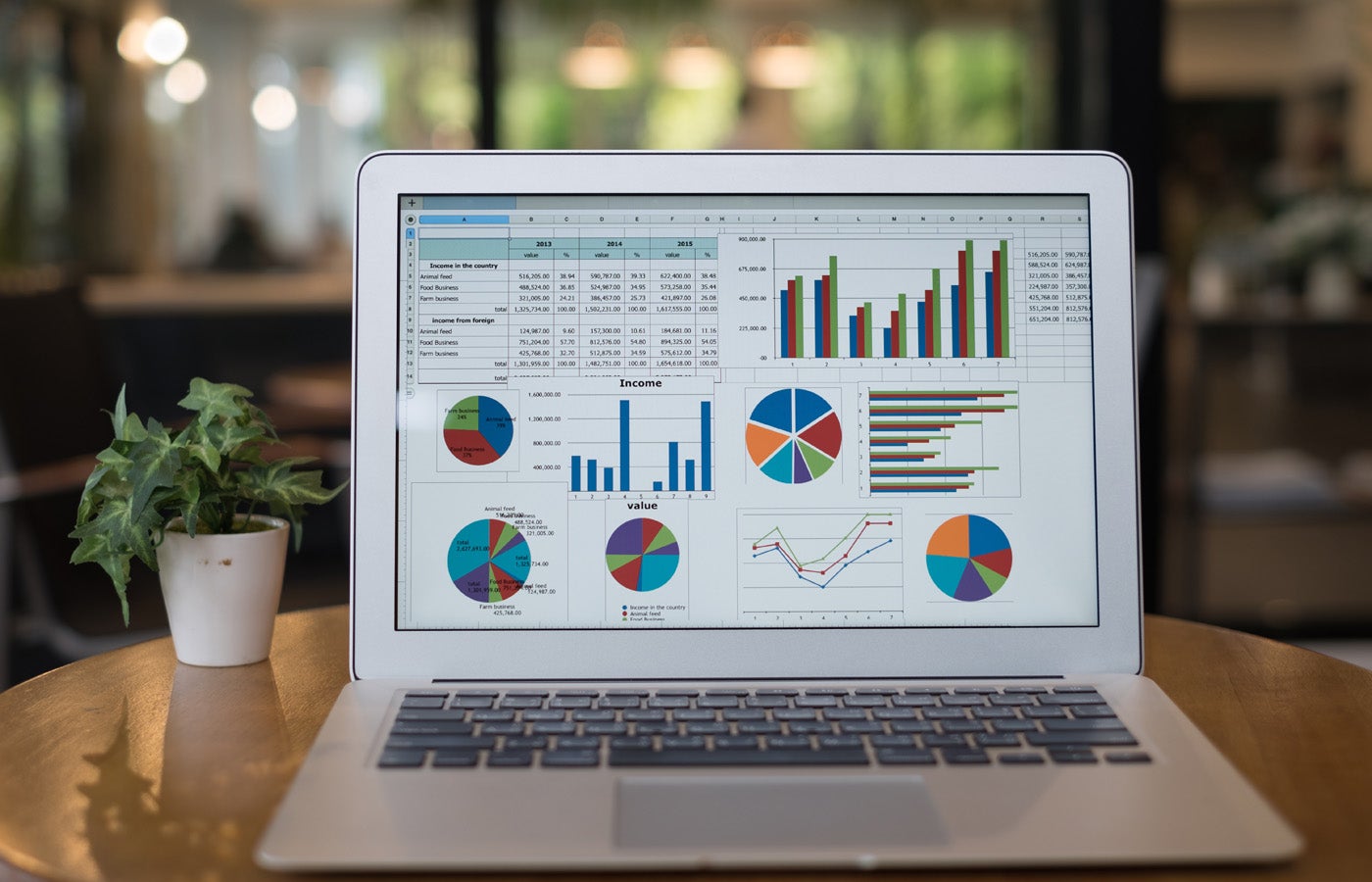Understanding finances is an essential aspect of running a successful business, but the days of tracking numbers on nothing more than a wing, a prayer and a spreadsheet are long gone. Instead, most businesses — including sole proprietors working for themselves and accounting departments at international corporations — automate financial tracking and reporting with accounting software.
Learn exactly what accounting software is, which features to look for and how to choose the best accounting software for your business with our complete accounting software guide below.
Sage Intacct's comprehensive cloud-based accounting software solution is a good fit for growing businesses that want bookkeeping basics and then some. |
Jump to:
- What is accounting software?
- Types of accounting software
- Desktop-based vs. cloud-based accounting software
- What’s the difference between in-house and outsourced accounting?
- What are the key features of accounting software?
- How much does accounting software cost?
- Pros and cons of using accounting software
- Choosing the right accounting software
- Frequently asked questions
What is accounting software?
Accounting software systems are software programs that help business owners, bookkeepers and accountants tackle time-consuming but crucial financial tasks related to running a business. The software also serves as a record of a business’s financial transactions, history and current fiscal status.
Most commonly, accounting software enables and automates tasks like the following:
- Sending invoices.
- Accepting payments.
- Generating financial reports.
- Recording expenses.
- Tracking cash flow.
- Reconciling bank accounts.
While accounting software can sync with payroll software to record vital financial information relating to payroll expenses, accounting software and payroll software are two distinct business software solutions.
Types of accounting software
General accounting software
General accounting software blends bookkeeping (the process of recording financial transactions) with accounting (analyzing bookkeeping information to make informed financial decisions) to support business’s financial processes. Comprehensive accounting software can save you time with features like automatic bank reconciliation, billing, invoicing and expense tracking features (and then some).
Billing and invoicing software
Billing and invoicing software is a more streamlined, simpler subset of accounting software. If you’re a freelancer who works with a handful of clients on a few projects a year, basic billing and invoicing software — rather than more comprehensive accounting software — probably have enough tools to keep you on top of your finances while making sure you’re paid on time.
At the same time, although billing and invoicing apps like Square Invoice and Zoho Invoice focus primarily on helping business owners bill their clients and accept payments, they often include basic bookkeeping features like expense tracking, project-based time tracking and basic expense reports.
ERPs
An enterprise resource planning solution, or ERP, is an enterprise-level software system that facilitates connections between departments and personnel at major corporations. ERPs like Oracle NetSuite offer the same set of tools as any basic accounting program, from general ledgers to billing and invoicing. However, ERPs support accounting on a massive scale along with offering features for managing sales, inventory, services, supply chains and personnel.
Desktop-based vs. cloud-based accounting software
Today, most accounting software is cloud-based, meaning its data is hosted on an off-site server that you can access anywhere as long as you have internet access, not just at your office. In contrast, desktop-based software is localized to your home or office, though modern desktop software usually comes with optional cloud-based expansions.
There are still a few desktop accounting software options on the market, such as Intuit QuickBooks Desktop. However, for the most part, desktop software is in the process of being phased out. Even Intuit pushes would-be QuickBooks Desktop users towards its cloud-based accounting software program, QuickBooks Online.
Desktop-based accounting software could be worth your time if you live in a remote area with unreliable internet access. It might also be a good pick if you need features you can’t get anywhere else. (For instance, the most expensive QuickBooks Desktop plan includes in-depth industry-leading reports that aren’t necessarily the norm for cloud-based options.)
But for most businesses, most of the time, cloud-based accounting software is a more accessible (and more fully featured) accounting solution than any desktop software alternative.
What’s the difference between in-house and outsourced accounting?
Accounting software makes it easier to keep bookkeeping and accounting in house no matter how big or small your business is. However, some business owners may prefer to outsource their bookkeeping and accounting tasks to a third party like a virtual bookkeeping service or individual CPA on retainer.
For the most part, accountants use accountant-friendly software like QuickBooks or Sage Intacct to keep their books, though some third-party bookkeeping companies rely on proprietary in-house software instead. Whether you work with an in-house team or outsource your accounting tasks, plan on interacting with accounting software in some capacity.
What are the key features of accounting software?
Invoicing and customer billing
Even the most basic accounting software should include an invoicing tool that lets you bill customers and clients for your goods and services. The software should also give you the ability to accept customer payments directly through the invoice. Ideally, it will support multiple payment options, including debit card and ACH transactions.
Some accounting software, such as FreshBooks, includes more advanced invoicing features like batched invoicing, automatic recurring invoicing and automatic charges for late payments.
Figure A.

Bank account and credit card syncing
Accounting software should automate redundant data entry by syncing with your bank accounts and tracking expenses in real time. Some accounting software services limit you to connecting one bank account and one credit card only. Others, such as Wave Accounting, include unlimited bank account and card connections.
Figure B.

Financial reporting
All accounting software should be capable of generating at least three essential accounting reports:
- An income statement, also known as a profit and loss statement, which catalogs your business’s total income and expenses over a given time period.
- A cash flow statement, which shows where cash is flowing into and out of your business.
- A balance sheet, which gives you a snapshot of your business’s assets, liabilities and shareholder equity at a specific point in time.
Together, these three accounting reports give you and any stakeholders in your business (like banks and lenders) crucial information about your business’s financial situation. Business owners, executives and shareholders use the information contained in these documents to maximize profits, minimize expenses and plan for a more profitable future.
Forecasting and budgeting
Accounting software does more than track your finances and categorize your expenses for tax time. Some plans and software programs, such as Xero’s highest-tier plan, will also help you prepare for future growth with forecasting and budgeting features that help you determine the best way to meet your future financial goals.
Cash flow forecasting is typically considered a more advanced feature that comes with mid-tier and top-tier plans, not entry-level accounting software plans.
Figure C.

Expense tracking and receipt scanning
Along with connecting to bank accounts to import and categorize your bank transactions in real time, accounting software should let you document other expenses, including employee expenses for reimbursement. For the most part, accounting software supports real-time receipt scanning and uploading so you always have an accurate financial record at your fingertips.
Bill management
While most accounting software should offer online payment acceptance with every plan, some also give you the ability to pay your own bills directly from your account. For the most part, bill management is considered a more advanced feature that comes with mid-tier plans and pricier accounting services only.
Third-party integrations
Ideally, accounting software should offer built-in integrations with other essential business software. The most common integrations are with payroll software, time-tracking apps and e-commerce solutions, but accounting software can also integrate with CRM, billing, budgeting, HR and other third-party software apps.
Some providers, including Wave Accounting, offer limited native integrations, though you can integrate any apps you want with a third-party solution like Zapier. Other accounting solutions, like Xero, offer more than 1,000 third-party integrations that can be seamlessly synced to its accounting software.
Mobile apps
Most modern accounting software tools now include mobile apps for easy, on-the-go financial tracking. Depending on the app, you should be able to see a quick overview of your financial health, track expenses, send invoices, accept payments and view basic financial reports from your phone or tablet.
How much does accounting software cost?
Generally speaking, the most affordable accounting software for freelancers, solopreneurs and other small-business owners starts at $0 to $25 a month for a basic plan. Mid-tier plans usually cost between $50 and $80 a month, and the most expensive plans generally run between $150 and $250 a month.
Naturally, the more features your accounting software offers and the more users it supports, the more expensive your monthly bill will be. Most (though not all) accounting software providers offer multiple plans so growing companies scale up to heftier software plans as they grow.
Additionally, while most cloud-based accounting services cost a monthly subscription fee, some providers (such as Zoho Books and FreshBooks) offer annual payment alternatives with discounts.
| Lowest plan price | Highest plan price | Per-user fees | Learn more | |
|---|---|---|---|---|
| Wave Accounting | $0/mo. | $0/mo. | $0/mo. | Try Wave |
| Xero | $13/mo. | $70/mo. | N/A | Try Xero |
| Zoho Books | $0/mo. | $240/mo.* | $2.50/mo. | Try Zoho Books |
| QuickBooks Online | $30/mo. | $200/mo. | N/A | Try QuickBooks |
| FreshBooks | $17/mo. | $55/mo. | $11/mo. | Try FreshBooks |
*When billed annually.
Small-business accounting software companies typically list their pricing upfront. More complex accounting solutions for enterprises usually require a degree of customization that makes it hard to offer an upfront price.
Pros and cons of using accounting software
Accounting software pros
Accounting software is a more affordable alternative to hiring an in-house team or outsourcing to a third party.
Sole proprietors and new LLCs might not have the budget for a part-time CPA or full-time in-house bookkeeper. Accounting software can help new business owners gain their financial footing without requiring them to spend above their budget.
Accounting software makes financial tracking accessible to non-accountant business owners.
Without a good grasp of basic accounting principles, it’s next to impossible to run a successful business. With accounting software, it’s possible to make sense of complicated financial data without a business finance degree.
Accounting software facilitates collaboration between business stakeholders.
Cloud-based accounting software facilitates easy, secure data sharing between your business’s financial stakeholders. Most accounting software includes free access for your accountant and allows for multiple users with customizable permissions, which means departments can get on the same financial page with relative ease.
Accounting software automates time-consuming data entry.
Manual data entry is a time-consuming process with a high risk of user error. Since accounting software automatically imports and categorizes transactions, it drastically reduces the possibility of introduced errors.
Plus, with automated software, you don’t have to spend hours a week entering expenses in spreadsheet cells or painstakingly updating a chart of accounts. Instead, your software does the heavy lifting so you can stick to managing daily business operations and expanding your profit margins.
Accounting software cons
Accounting software may have a steep learning curve.
The best accounting software aims to simplify complex accounting processes for non-accountants, but that doesn’t mean basic accounting principles are easy to pick up right off the bat. Plus, the software itself will likely take some getting used to, which means you’ll have to spend at least some time setting it up and familiarizing yourself with its interface.
Accounting software can be expensive.
Free accounting software is only an option for the smallest of businesses. As your business grows, you’ll have to scale up to more robust — and more expensive — accounting software plans.
Choosing the right accounting software
Finding the right accounting software for your business can be an in-depth process that requires you to invest a good deal of time and energy upfront. However, putting in the work to find the best accounting software for your unique situation is well worth the effort. Follow these steps to get started.
1. List your accounting software priorities.
Before you start shopping for software, it’s important to consider what you really want out of your accounting solution.
For instance, are you a service-based freelancer who needs solid mobile invoicing and expense categorization for easier end-of-year tax filing? Does your multi-member LLC need collaborative software that facilitates communication between stakeholders? Are you a first-time business owner looking for a simple solution with a relatively low learning curve and multiple plan options so you can scale to software with more features as you grow?
2. Determine which accounting features you can’t live without.
Once you know broadly what you want out of your accounting system, it’s easier to narrow down which software features you need to meet your business goals. Ask yourself questions like these to figure out what accounting features you need your software to include:
- Do you need software with an app so you can analyze finances on the go, or do you tend to work from your laptop and can stick with a browser-only solution?
- How important is it to you to find accounting software that integrates smoothly with other business software tools you already use?
- Do you need a comprehensive general ledger and chart of accounts, or can you get by with basic income and expense tracking?
- How many people will be collaborating with you on your accounting software program?
- Do you want software that helps you manage bill payments, or are you happy with your current bill payment process?
3. Decide on an accounting budget.
Most accounting software providers are relatively straightforward about their starting prices, though more comprehensive programs for bigger businesses may require a custom quote. When budgeting for an accounting solution, make sure to consider the following:
- Additional feels for extra users.
- Discounts for paying annually instead of monthly.
- Money-back guarantees.
- Plan scalability.
4. Research the best accounting companies.
There’s no shortage of accounting software providers to choose from, which can make the research process feel overwhelming at first.
Instead of vetting hundreds of potential options on your own, check out review round-ups of popular accounting software for businesses like yours. Our guide to the best accounting software for small businesses can help you get started.
5. Sign up for a free trial or schedule a free demo.
Most accounting software companies offer free trials. (The industry standard is usually 30 days or one month free.) Make sure to read the fine print when you sign up: Some software requires you to enter a credit card that will be charged automatically if you don’t cancel by a certain date.
Enterprise-level accounting solutions tend not to offer free trials. Instead, interested parties should schedule a free demo with a sales representative. During the demo, you’ll be able to ask specific questions about how the software could benefit your company.
6. Reevaluate as needed.
Once you’ve taken your potential accounting software solution for a test drive, you can sign up for your favorite product and get to work organizing your company’s finances.
However, it’s important to bear in mind that your business’s financial software needs will change over time. If you outgrow your current accounting software, you can always switch to a different provider whose features better fit your trajectory for growth.
Frequently asked questions
What’s the most used accounting software?
Intuit QuickBooks Online is one of the most popular cloud-based accounting software services used by small, midsize and large businesses across the world. Other popular cloud-based accounting solutions include Sage Intacct, Xero, FreshBooks, NetSuite and Zoho Books.
Which software is most commonly used by accountants?
Many bookkeepers, CPAs and accounting firms use QuickBooks Online or Intuit QuickBooks Desktop, but Sage Intacct and Sage 50 are popular options as well. Many firms also use Xero, NetSuite and FreshBooks.
What is the best accounting software for small business?
Zoho Books is one of the most fully featured and scalable accounting solutions for small businesses. Its general ledger and chart of accounts are ideal for small-business owners new to bookkeeping, and it offers enough plans to support businesses scaling from startups to multi-entity companies.
However, the best accounting software for your business depends on your needs and budget. While Zoho Books could be a good fit for another company, your ideal accounting program might be an in-depth solution like Sage Intacct or a free tool like Wave.
Learn more about the best accounting solutions for all business types and sizes by reading our review of the year’s best accounting apps and software.
Is accounting software expensive?
No, accounting software doesn’t have to be expensive. Some accounting software, like Wave Accounting, is completely free. Alternatively, providers like Zoho Books offer a free plan for small businesses with an annual revenue below $50,000 USD.
Pricier solutions built for large enterprises with dozens of users can cost hundreds of dollars a month, but there are plenty of middle-ground options that start at less than $20, including Sage Accounting, FreshBooks and Xero.
Read next: Best Accounting Software for Multiple Businesses (TechRepublic)








